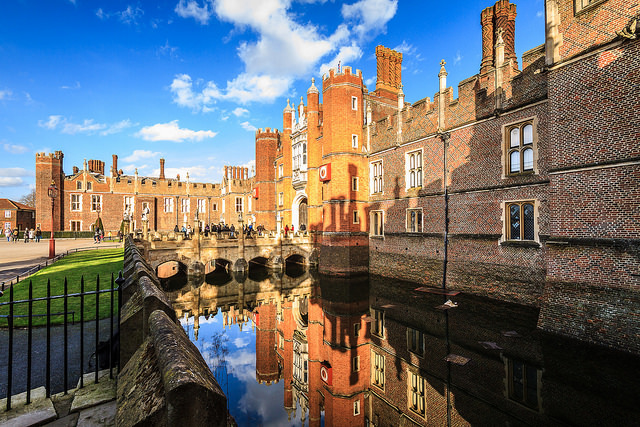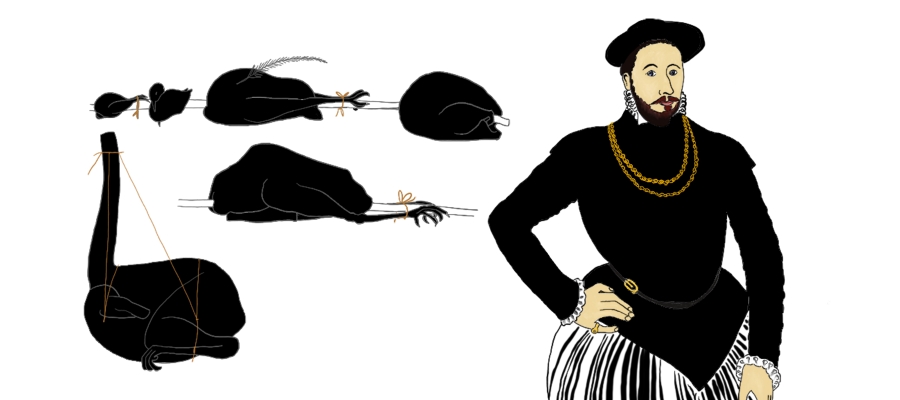Food during the Tudor period in England is a fascinating topic, so we're going to tell you all about it! We’re focusing on food in wealthy households - particularly the royal household, and even more particularly, the household of King Henry the 8th. Why are we focusing on the royal household? It’s because that’s where the action was. Back then, you didn’t have star food critics telling you where to eat, or popular food blogs setting new food trends - instead, you had royalty and the wealthy setting trends.

No one knows more about Tudor period food than Peter Brears (author of the book “Cooking and Dining in Tudor and Early Stuart England”). He has had the unique experience of living in Hampton Court Palace and working in Henry the 8th’s kitchen. Before him, no one had been into the kitchens to actually cook since the 1730s when the court moved out. He was asked by the Historic Royal Palaces Agency to get the kitchen going so it could be used like it had been used in the 1530’s (so that would’ve been during King Henry the 8th’s reign in the Tudor period). What better way to find out how roasting fires worked or how they cooked over charcoal stoves than by experience it first hand in the original buildings? By walking through the buildings and carrying things while opening doors, you realize why things were laid out the way they were. As Peter Brears explained to us, these are things you can't learn from just reading records and plans. We're excited to share what we learned!
A Time of Food Exploration
There were 2 reasons why this was a time of food exploration. First of all, the “food rules” (ie. conventions) had not yet been established. Bacon and cream, fruit and onion - you could combine things that didn’t go together quite as easily as, say, cheese and bread would. And the recipes were written quite differently than what we’re used to today. Recipes often left out the details - like how long to cook something for, or how much of an ingredient to add. This was because recipes assumed that if you were cooking, then you were probably an experienced cook. Remember that cooking was a job - not a hobby. Early recipes were not written for amateur cooks - they were for professionals that were brought up through the apprentice system. People that used recipes would look at a list of ingredients and know exactly how to put it together and get the right kind of taste.
Now, for the second, more important reason that led to food exploration - The Dissolution of the Monasteries. Basically, Henry the 8th wanted a son to take the throne after him, but since his only surviving child with his wife was a daughter, he wanted to get his marriage annulled so he could take on a different wife. The pope refused. Eventually, Henry the 8th broke from the church, disbanded all the monasteries, and took the land. As a byproduct of that, he had started an enormous social revolution. Huge areas of England had been owned by the church - by closing down the monasteries and privatizing the land, a new mercantile class emerged. Much of the land was sold to the rich. This had a trickling down effect - some of the buyers turned around and sold smaller pieces of their land, and those buyers turned around and sold smaller pieces of their land - so you could have buyers that were lower down on the social scale. With the new land available, some people expanded their business ventures, and some people started new business ventures. It was a sort of economic boost that led to people having the extra money to spend on luxuries. People updated their homes with the best materials, and outfitted their kitchens with the latest in kitchen technology. Soon, the old cooking traditions were pushed out, and recipes from other parts of the world were adopted, including recipes from places like France, Italy, Germany, Holland, and Turkey.
The Tudor period also saw the decline of the feudal system - a decline which had started before the Tudor period. In England, feudalism had shaped the social structure with a clear hierarchy established around land-holding (I say land “holding”, instead of land “owning” because only the king “owned” land). Higher up families had lots of staff working for them, and because the social structure was largely fixed, families and their staff developed strong ties generation after generation. For example, if someone was working for your family, then it’s likely that their parents had also worked for your family, and their grandparents too, and their great grandparents, and so on, so you would then have the responsibility of employing their kids and their grandkids and their great grandkids and so on. The newly rich of this period did not feel such responsibilities towards staff members, because no multigenerational ties had been established. So they tended not to employ as many people - extra staff cost money. This had an effect on the hospitality - with less staff, there were simply less people to provide services and prepare food or drink. And it wasn’t just the quantity of staff that had changed, but also the quality - previous staff members had multigenerational ties to their employers, so they were loyal and well brought-up.
A lot of the duties left behind by the decrease in staff went to wives. Aside from more management duties, they also took on the preparation of high quality dishes. It wasn’t just upper class wives filling roles left behind by the loss of gentlemanly staff, but women in general started taking on roles in the kitchen. For example, we see the earliest known records of female cooks in England in the 1500s.
Another change in this period was an increase in fresh produce - market gardens were established and a wide variety of produce became available. But we should note that people didn’t like to eat these things raw, so salads had a bad reputation - people believed salads got you sick. When you think of the quality of the water of the period - that's probably the reason why...if you had uncooked vegetables which had just been rinsed in water, which was probably toxic, it was probably going to make you ill. This is why people never drank water - everyone drank ale, because that had been brewed/boiled and was sterile.
As for what meats they ate, the only important change at this time was the introduction of turkey (probably starting in the 1520s) - turkey largely replaced peacock in this period. A lot of different birds were eaten, including swans and seagulls. Interestingly, seagulls were fattened for some time in poultry yards after being caught, because this got rid of the fishy flavor from their diet in the wild.
Kitchen Careers
Most people that had a professional career in kitchens started work as children, getting paid 1-2 pounds/year, plus free food. Kitchen boys could be promoted from turnspit to groom to yeoman to sergeant cook. These all worked under the Master Cook. Master Cooks were like executives of the kitchen - they had a lot of power and influence, but also a lot of responsibility. Unlike today, they didn't have the benefits of things like refrigeration, tinned foods, and electrical appliances, so keeping everything running smoothly was no easy task. Oh, and let's not forget that there were a lot of mouths to feed per household.
Above the Master Cook was the Clerk of the Kitchen. This person was in charge of the entire administration. We know from records and paintings that the Clerk of the Kitchen was paid handsomely - they were adorned with expensive clothes. The Clerk of the Kitchen had departments below him, including an accounts department, sited over the entrance of the building so that they could see everything coming and going. It was also conveniently placed where you could make payments and check out all the details.
Then there were various other departments. There was a department for everything. For example, the Woodyard dealt with fuel, the Scullery dealt with utensils, the Buttery dealt with beer, the Cellar dealt with wine, and the Pantry dealt with bread. All these different departments were supervised by the Clerk of the Kitchen. It’s no wonder he was well paid - it was a big job. In the year 1539, the modern equivalent of 7 million pounds was used to provide food for the royal household. That’s over 8 million us dollars.
Perks of the Job
The staff working in wealthy homes got perquisites. If you abbreviate the word “perquisite”, you get the word “perk”, which is exactly what perquisites are. Perquisites were the perks you were promised as a staff member. If you worked in the boiling house, you could catch and keep the delicious juices dripping from roasting meats. If you served the food, you could keep the meats that people didn’t eat (these were called “unbroken meats”). You could even make money off of your perquisites. For example, if you worked in the Royal Household and you got to keep untouched meat dishes, you could sell them. Lots of people visiting the Court were not fed on the king’s dime, so they had to buy food.
Surprising Fun Facts
A lot of things about cooking and dining in the Tudor period surprised us. It’s not like how Hollywood portrays it in movies - like the scenes where people are biting off large chunks of meat then throwing the bones over their shoulders and swigging lots of alcohol - that’s not correct. Banquets were a place to show off your breeding by exhibiting good manners...people just wouldn't behave like that...it was very formal. For example, if a lord or King wanted a drink, he would catch the eye of a cup bearer. Part of the cup bearer’s job was to make sure the wine had not been poisoned by drinking it himself. First, the cup bearer would pour wine into a cup with a cover, he would then bring this over to the table, kneeling before it, and then take the cover off the cup to pour a few drops into it to drink himself to check that it’s okay for the lord or king to drink, then he’d wipe the rim of the cup with a napkin, then finally give it to the lord or king, who would then take a sip then pass it back. This would happen throughout the meal whenever they wanted a drink.
Another complete surprise was that kitchens were freezing cold in some parts, while of course really hot anywhere near a fire. In fact, sometimes there were indoor snowstorms. Even with clear skies outside. Although there were big fires, kitchens got really cold - they pulled in a lot of cold air from outside.
Final fun fact - Hollywood got something wrong (maybe on purpose). Until Henry the 8th brought in the regulation that kitchen staff had to wear clothes - many of them worked naked - but you don’t see that in the movies.
______________________________________________________
Special Thanks to Our Interviewee:
Peter Brears - author of "Cooking & Dining in Tudor & Early Stuart England"

